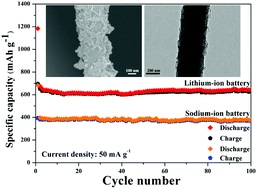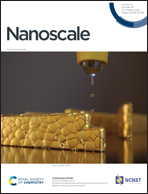The electrochemical storage mechanism of an In2S3/C nanofiber anode for high-performance Li-ion and Na-ion batteries†
Abstract
There are only a handful of reports on indium sulfide (In2S3) in the electrochemical energy storage field without a clear electrochemical reaction mechanism. In this work, a simple electrospinning method has been used to synthesize In2S3/C nanofibers for the first time. In lithium-ion batteries (LIBs), the In2S3/C nanofiber electrode can not only deliver a high initial reversible specific capacity of 696.4 mA h g−1 at 50 mA g−1, but also shows ultra-long cycle life with a capacity retention of 80.5% after 600 cycles at 1000 mA g−1. In sodium-ion batteries (SIBs), the In2S3/C nanofibers electrode can exhibit a high initial reversible specific capacity (393.7 mA h g−1 at 50 mA g−1) and excellent cycling performance with a high capacity retention of 97.3% after 300 cycles at 1000 mA g−1. The excellent electrochemical properties mainly benefited from In2S3 being encapsulated by a carbon matrix, which buffers the volume expansion and significantly improves the conductivity of the composite. Furthermore, the structural evolution of In2S3 during the first lithiation/delithiation and sodiation/desodiation processes has been illustrated by ex situ XRD. The results confirm that the reaction mechanism of In2S3 in both LIBs and SIBs can be summarized as conversion reactions and alloying reactions, which provide theoretical support for the development of In2S3 in the field of electrochemistry.



 Please wait while we load your content...
Please wait while we load your content...